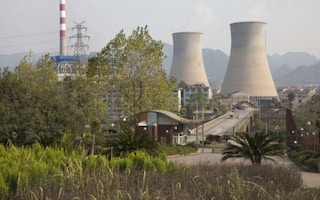The country’s power plants should burn more poor-quality coal, leaving better coal for smaller coal-burning enterprises that lack emission controls — a move that would reduce pollution, it has been suggested.
This recommendation is in a newly released study co-authored by the China Electricity Council and the Environmental Defense Fund, an international environmental NGO based in New York City.
“Power plants should be encouraged to use more brown coal and coal with high sulfur content, and to conduct highly efficient pollution control measures, in a bid to reduce the total emissions of society,” said the study, which was released on Tuesday.
Wang Zhixuan, secretary-general of the China Electricity Council, said the nation’s power plants used about half of the 4 billion metric tons of coal burned in 2012. But at least 1 billion tons of the rest was used by small coal-burners, such as residences and small enterprises, which seldom adopt pollution-reduction measures when burning coal, he said.
Power plants, on the other hand, have the ability to control emissions to a certain level even if they use coal of poor quality, he said.
“The more low-quality coal that power plants burn, the less will be used by small burners,” he said.
Dai Bing, director of the coal industry information department at JYD Online Corp, a Beijing-based bulk commodity consultancy, agreed.
“Usually, medium and large-scale power plants have high-end facilities and equipment for environmental protection,” he said. “It can effectively reduce emissions and pollution if the government encourages these plants to use more brown coal as fuel.”
However, the problem is how to supervise their production processes so that they will strictly follow the emission reduction process, Dai said.
An industrial insider with a coal-fired power plant under one of the top five power generation groups, who declined to be named, said most plants would welcome the measure because using brown coal will reduce costs.
“Thus, the company can use the money saved to improve facilities for environmental protection,” he said.
But environmental experts weren’t convinced.
Wang Yuesi, a researcher at the Institute of Atmospheric Physics under the Chinese Academy of Sciences, said he does not think such a move will ease air pollution.
“Instead of leaving the good-quality coal to the small and medium-sized enterprises and consuming brown coal themselves, it seems a better idea for the large State-owned power plants to offer technological support to help those small companies reduce their emissions,” Wang said.
He said the problem does not lie in the amount or type of coal being burned, but in weak environmental protection enforcement, which, in his view, should be much tougher than foreign countries’ standards, given China’s situation.
The study said China’s power sector has increased efforts to cut pollutants and carbon emissions in recent years.
With an increase of more than 7 percent in the overall installed capacity compared with the previous year, total sulfur dioxide emissions were reduced by 3.3 percent, it said. But sulfur dioxide emissions from this sector still accounted for almost 42 percent of the country’s total emissions in 2012.
“The effect of emissions from the power industry on air quality is still relatively large, but it is gradually being reduced on a yearly basis,” said Dan J. Dudek, vice-president of the China office at the Environmental Defense Fund.










